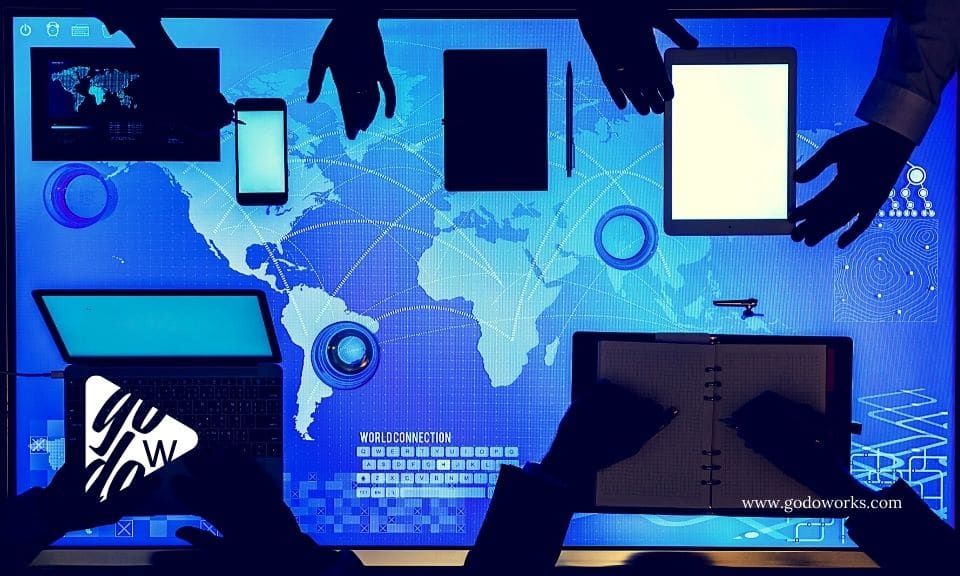As technology advances, our life in general is changing in different ways, geo-productivity and gegestion are here to stay. Why? The way we shop, entertain ourselves and even the way we receive services such as healthcare has changed dramatically with the full penetration of the internet and smart mobile devices.

Work and its dynamics do not escape this reality. Enormous changes are already being generated in the different industries that correspond to a great premise; technology and connectivity make that time and distance are no longer limiting.
This is how the terms Geoproductivity and Geomanagement are introduced in practically all industries.
What are Geoproductivity and Geomanagement?
In a nutshell, Geoproductivity is the value relationship that is generated between collaborators who are located in different geographical locations simultaneously.
GeoManagement, on the other hand, is the evolution of traditional management towards a management oriented to liquid organizations, i.e., breaking their traditional structures and becoming present in several geographical locations through their field collaborators. This type of management allows the design, execution, management and control of decentralized processes in the most optimal way.

To be very clear, through a good GeoManagement we will be improving our GeoProductivity and vice versa, the best way to increase our GeoProductivity is to improve our GeoManagement. Working on them will have as a consequence the optimization of resources of our activity and ultimately a maximization of benefits.
How to increase your GeoProductivity through GeoManagement?
As mentioned above, the challenge of Geoproductivity and GeoManagement is to break the barriers of physical distances and time. This in no way means that the factors of time and space are not important, but on the contrary, perhaps we are in the historical moment in which these aspects are more valued and when we have to emphasize them more.
Our main challenge is to understand these factors and ensure that they are not a barrier when it comes to providing value and being able to offer services in wider geographic areas.
Perhaps more than breaking the barrier of time and space, the main challenge is to use both elements to our advantage, breaking our own ceilings and allowing us to generate greater value.

Such a task cannot be achieved without taking action along two major strategic lines;
Implement technological tools and, of course, acquire new practices and knowledge.
In this way, we can affirm that our geoproductivity and geomanagement depend on how much knowledge and tools we have at our disposal.
What technology is used to improve my GeoManagement?
Geo Management Software (GMS) are the main technological tools used to improve Geoproductivity and GeoManagement.
Its main features are to provide operational mobility to employees, allowing them to perform their tasks regardless of their geographic location, and to provide a holistic view of the business to decision makers, allowing them to optimize resources and maximize their benefits in real time.
Any SGG can be linked to other internal systems such as a CRM like Hubspot, an ERP like SAP, BI or whatever software you use.
Learn more about GoDoWorks
In order to understand how the GGS works it is very important to understand the following concepts:
Operational mobility
This is achieved by providing employees with mobile devices that allow them to acquire new capabilities that drastically increase the value they can deliver. In this way, with a mobile device, an employee can perform tasks that until recently could only be performed at the central offices of an organization.
Operational mobility gives the employee the possibility of always having the necessary resources to carry out his or her tasks and also the possibility of providing better service to end users, since he or she can respond to their concerns immediately.
We can say that the main characteristics that a mobility tool gives to a field collaborator are contextual relevance and fluency.
Contextual relevance
It is the ability of the collaborator to adapt to the context in which it finds itself without changing the value it delivers. For example, a medical emergency mobile can have the patient's medical history in real time and no matter if the patient changes, the physician will have the relevant information at all times.
Contextual relevance is thus the ability of an employee to deal with the n cases that are foreseen within his or her workflow.
In today's dynamic world, it is very difficult to foresee 100% of the cases that a field employee may encounter, but we can certainly make our best effort to cover most of them and therefore mitigate downtime for employees and also raise the perception of end users who undoubtedly greatly value efficiency when receiving their solutions.
Logistical fluidity
It is the ability of the collaborator to exchange information with the central office in a dynamic way, often without even having to generate a specific action. Returning to the same example, the mobile emergency mobile can share its geographic location in real time and the next calls to be answered will be decided from the central office without the field collaborator having to make complex decisions.
An employee with a mobility tool will have the right tools for all situations and will be able to receive and send information without much effort.
Field worker fluency is not a minor point. Effortless data submission generates high quality data as it does not rely on manual data entry.
This type of data is enormously more valuable than data obtained through data entry on paper forms because it has a lower error rate and is generally easier to sort because it is digital from conception to final use.
This data generates a very important link between the employee and the decision-maker since it is transformed into information once the SGG orders it. This information is transformed into intelligence once the software uses its analysis and prediction tools and finally it is transformed into intelligent decisions once the decision maker takes advantage of his holistic managerial vision to adjust the work of the field collaborators according to the business objectives.
This is known as Holistic Management Vision.
The Holistic Management Vision
It is the ability of a decision-maker to have a complete picture of what is going on with his or her employees.
Through operational mobility you get real-time data and through different dashboards and reports you can take actions to improve results.

The main characteristic of the holistic management vision is the automatic collection of data, the transformation of this data into ordered information, the generation of intelligence from the information, the possibility of taking action and finally the complete vision of the whole process that allows you to plan, execute and control in real time.
The holistic vision generated by the use of a Geo Management Software (GMS) allows the organization to optimize resources from the dynamic planning in real time since having a digitized data input, allows making decisions in real time that may vary according to different factors.
A clear example of this is when an organization has several maintenance crews in the field that are responsible for repairing different services in different parts of the city.
By having data such as the average time that these types of repairs take, the distance between repair points and the urgency of each repair, it is possible to predict which repair will have to be performed by which team at a later date. More importantly, the process can be quickly adjusted if any variable changes, such as a change in the priority of attending to one or another repair or if any of the repairs take more or less time than expected.
Almost immediately this could be reflected in the work schedule of the different crews and decision makers could follow up on the case and not lose sight of the business objectives.
Holistic management vision and operational mobility meet at what is arguably the most critical point in a GeoManagement ecosystem; Mobile Workflow.
Mobile Workflow
It is the dynamic process that generates specific tasks for field collaborators from an automated system or a command from a decision maker. Each action taken by an employee is reflected in the Mobile Workflow and is monitored by the decision maker who, in case of detecting an opportunity for improvement, generates changes on the workflow that finally impacts the employee's tasks.
In this way, direct contact between the decision-maker and the employee is eliminated to a minimum, allowing technology and processes to arbitrate between the two, except in very specific cases, thus achieving a more optimal workflow for both parties.

The main characteristic of a Mobile Workflow is that it is focused on the operational mobility of an organization, that is, it is prepared to have a totally variable data input, which generates a workflow that, in addition to being focused on mobile collaborators, also has to have certain flexibility in its processes to adjust to each circumstance.
A clear example of this type of WorkFlow is generated in logistics companies where factors such as traffic have a direct impact on delivery time and is not always predictable.
The information on estimated delivery times can be sent automatically through an SGG and it is perfectly possible to estimate the times and persons responsible for the following deliveries.
In this way the Mobile Workflow for that organization dedicated to transportation will be an always dynamic flow both in its data entry and in its distribution of specific tasks to the different collaborators.
When to start thinking about your GeoProductivity and GeoManagement?
While it is true that all organizations can optimize their processes, there are some parameters that make your organization ideal for implementing GeoManagement strategies.
Normally Geo Management software are very powerful tools that justify their implementation, training and execution once the data to be processed are difficult to process without using technology.
Studies conducted by the GoDoWorks Business Intelligence team determine that organizations with more than 20 employees outside the central office are the ones that benefit the most from implementing GeoManagement tools, optimizing their field resources by an average of 20% to 40%.
What are the first steps to start improving my GeoManagement?
- Define if my organization is a match and can benefit from applying this type of tools.
- Design a Mobile Workflow. In general, companies that provide a SGG have consulting teams that will be in charge of this task. Undoubtedly, this is the most critical point of the whole process. Technology and knowledge are useless if they are not oriented to improve the workflow.
- Implementing a GMS: Once it has been determined that the organization is a perfect match for GeoManagement and having defined a Mobile Workflow that optimizes resources from a conceptual point of view, it is time to bring the concepts down to earth and for this it is essential to implement a GMS. In short, it is the tool that allows us to improve our GeoProductivity.
- Optimize, Optimize and Optimize: Once the tool is implemented we cannot think that everything is done. Like any tool, it requires attention and professionalization that only time and experience will provide. It is fundamental to schedule instances of adjustments in the early stages of implementation to customize your SGG to your specific needs.
- Training and Certification: A tool is only as powerful as the person who uses it. Undoubtedly, this type of technological processes must be at the service of the people who make up the organization and for this to be possible it is essential to master the available tools. In this sense, it is considered a minimum requirement to receive periodic training and, in general, this is reflected in a GeoManagement Certification (CGG). The certification provided by GoDoWorks is a standard in the market, accepted by the entire industry as a guarantee of competence in GeoManagement as a discipline of study and in GGS as a work tool.
In short, there are many variables that have a direct impact on the productivity of your business, many of them have been changing due to technological changes. We must mutate with the same speed in order not to be submerged in a very competitive market.
With that in mind, it makes sense to generate specificity and take actions specifically oriented to the industry in which your organization operates, since it is not enough to apply general rules to your particular cases.
That is why if your organization has the great challenge of managing its resources in different geographical locations, do not hesitate to apply GeoManagement tools.
Breaking the barriers of time and space is not only possible, but you can also transform these precious resources into your main allies.
With such strengths, there will be no limits to your productivity.
